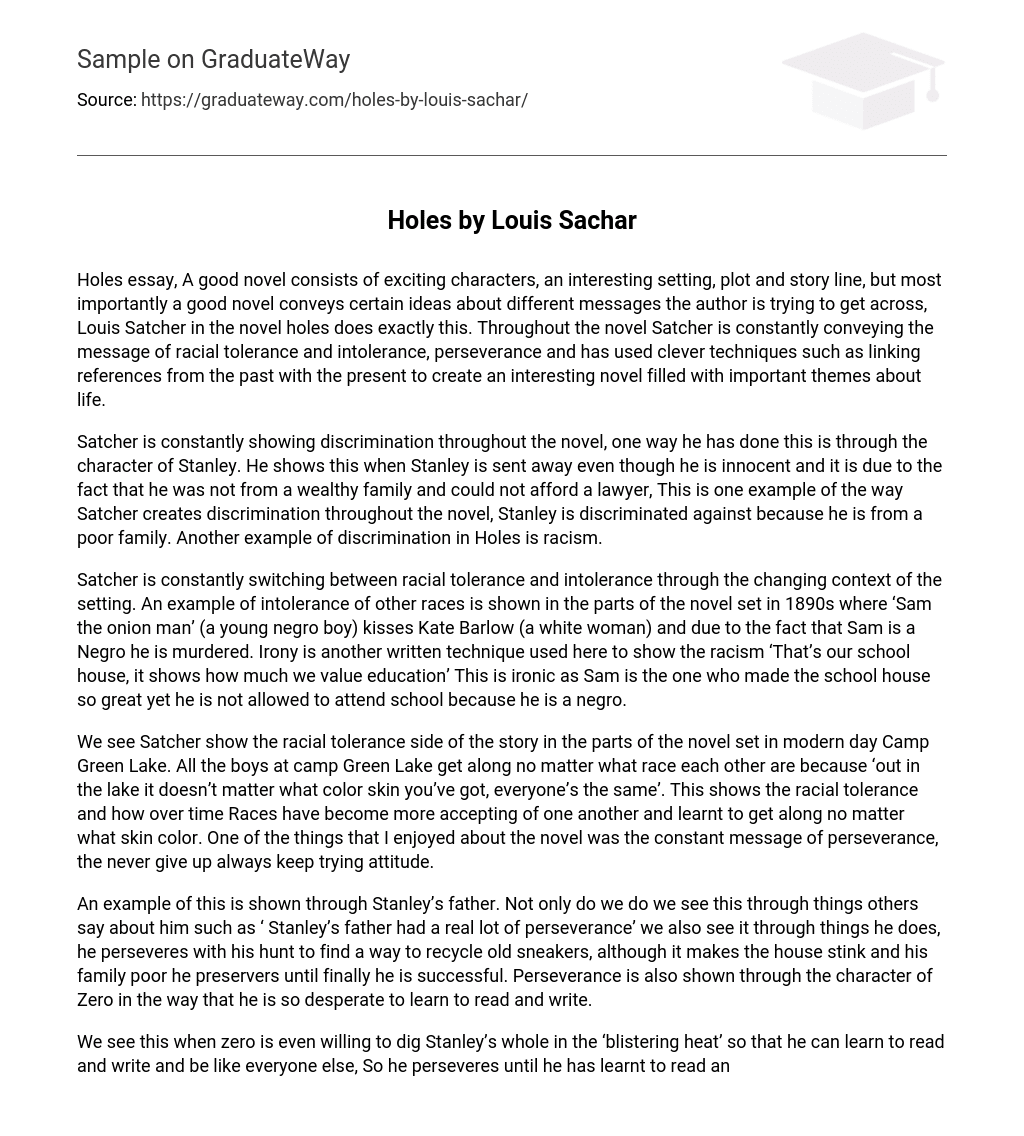In the novel “Holes,” Louis Satcher effectively communicates several important themes about life, such as racial tolerance and intolerance, perseverance, and the connection between past and present. A good novel not only features exciting characters, an interesting setting, plot, and story line, but also conveys the author’s ideas and messages. Satcher achieves this by skillfully linking references from the past to the present, resulting in a compelling and meaningful narrative.
Throughout the novel, Satcher consistently portrays discrimination through various characters and situations. One instance of this is evident in the character of Stanley, who is unjustly sent away despite his innocence. This unfair treatment is solely based on the fact that Stanley comes from a less affluent background and cannot afford legal representation. This example highlights how Satcher perpetuates discrimination by depicting Stanley as a victim due to his lower socio-economic status. Additionally, racism is another form of discrimination showcased in the novel, Holes.
Throughout the novel, Satcher portrays a constant fluctuation between racial tolerance and intolerance, which is heavily influenced by the surrounding circumstances. In the sections set in the 1890s, there is a clear display of intolerance towards individuals of different races. For instance, when ‘Sam the onion man,’ a young negro boy, shares a kiss with Kate Barlow, a white woman, he is tragically murdered solely due to his race. Additionally, irony is employed as a literary device to highlight the prevalent racism within society. An example of this irony can be seen when someone remarks, ‘That’s our school house, it shows how much we value education.’ This statement becomes ironic because despite Sam’s significant contribution to the development of the schoolhouse, he is unjustly barred from attending school solely based on his race.
We can observe Satcher’s portrayal of racial tolerance in the sections of the novel that take place in modern day Camp Green Lake. Regardless of their race, all the boys at the camp are able to get along with one another, as “out in the lake it doesn’t matter what color skin you’ve got, everyone’s the same.” This demonstrates the acceptance of different races and how they’ve learned to coexist despite their skin color. Additionally, a recurring theme in the novel that I found satisfying was the importance of perseverance and maintaining a never-give-up attitude.
An example of this is illustrated by Stanley’s father. We witness this not only through the comments made by others such as ‘Stanley’s father had a tremendous amount of perseverance’, but also through his actions. He persists in his quest to find a method for recycling worn-out sneakers, even though it produces a foul odor in the house and causes financial difficulties for his family. Nonetheless, he perseveres until he ultimately achieves success. Perseverance is similarly demonstrated by the character Zero, who exhibits an intense longing to acquire literacy skills and eagerly endeavors to learn how to read and write.
We witness this in the novel, when Zero is willingly digging Stanley’s hole in the scorching heat, driven by his desire to learn how to read and write and assimilate with others. He persists until he successfully acquires these skills. However, perseverance is not always portrayed positively in the story. The character of the Warden exemplifies how perseverance can lead to negative outcomes. After years of tireless dedication and determination to locate Stanley’s grandfather’s suitcase, she becomes consumed by obsession and turns into a malicious individual. This is evident when she physically strikes Mr.
Sir on the face with her nails of rattlesnake venom, this situation in the novel portrays perseverance as a negative attribute. The novel incorporates humor by utilizing peculiar elements like smelly feet, peaches, and onions. These humorous elements establish a connection between the past and present of Camp Green Lake and also create links between the characters. For instance, both Trout Walker from olden day Camp Green Lake and Clyde Livingston suffer from the same foot disease.
Another example of these links is found when Stanley discovers the lipstick that was once owned by ‘Kissin Kate Barlow’ from the old Camp Green Lake. Irony is also employed in connecting the old Camp Green Lake to the modern Camp Green Lake, such as when Kate Barlow stole from Stanley’s great grandfather and caused his family to become poor. Interestingly, at the end of the novel, it is because of her that you gain a significant amount of money.





